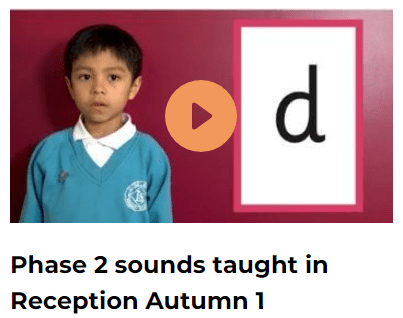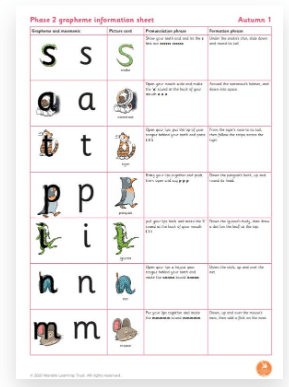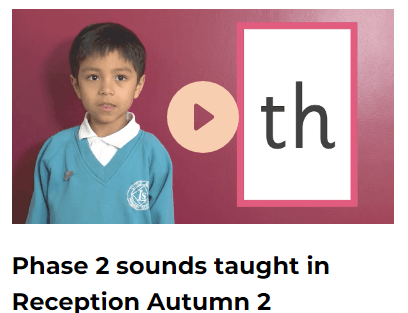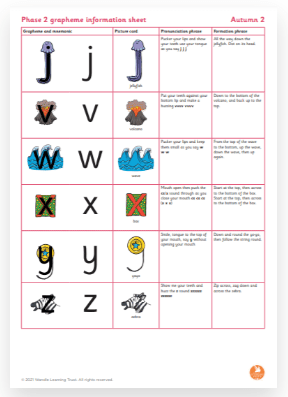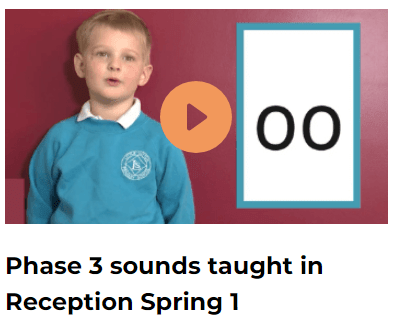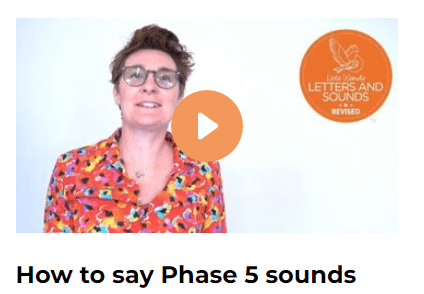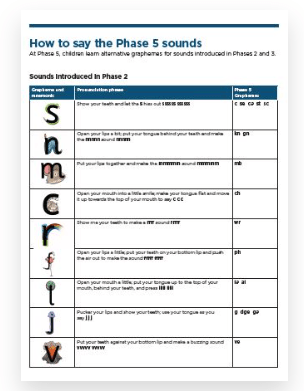Phonics & Early Reading
The more that you read, the more things you will know. The more that you learn, the more places you’ll go.
Dr Seuss
Early Reading and Phonics Intent
At Our Lady and St Brendan’s, we believe that all our children can become fluent readers and writers and we are committed to ensuring that this is achieved for all of our children regardless of any barriers that they may have to their learning. This is why we teach reading through Little Wandle Letters and Sounds Revised, which is a systematic and synthetic phonics programme.
Our aims are for pupils to:
- Build on their growing knowledge of the alphabetic code, mastering phonics to read and spell as they move through school.
- Be equipped to tackle any unfamiliar words as they read.
- Read confidently for meaning and regularly enjoy reading for pleasure.
- See themselves as readers for both pleasure and purpose.
- Be taught fidelity to the Little Wandle Letters and Sounds Revised programme
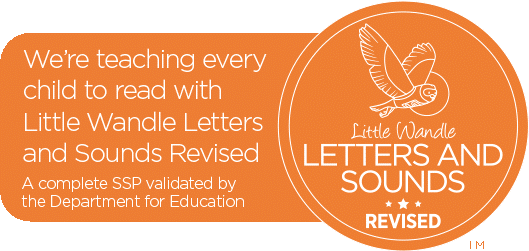
Implementation
Little Wandle is the only scheme used throughout school as we know that a consistent approach gives our children the best chance of success. We teach a synthetic phonics programme. We start teaching phonics in Nursery/Reception and follow the Little Wandle Letters and Sounds Revised progression. Every adult at Our Lady and St Brendan's is trained to deliver Little Wandle phonics and reading to ensure that phonics and reading are delivered in the same way in every year group and by every adult. This includes all adults using the same language, the same routines and the same resources. Weekly content grids, lesson templates and ‘How to’ videos all help to ensure that all adults maintain consistency in their teaching and this is monitored half termly by the Reading Leader and SLT so that any misconceptions or inconsistencies can be rectified as soon as possible. We also model the application of the alphabetic code through phonics in shared reading and writing, both inside and outside of the phonics lesson and across the curriculum. We have a strong focus on language development for our children because we know that speaking and listening are crucial skills for reading and writing in all subjects.
Overview of Little Wandle Letters and Sounds Revised at Our Lady and St Brendan's:
Click on the link below to find videos and resources on the parents section of the Little Wandle website
For parents - Letters and Sounds (littlewandlelettersandsounds.org.uk)
Reception
Children make a strong start in Reception and access phase 2 of the Little Wandle phonics programme as soon as possible, usually in week 3 of the Autumn term when children are settled in their new routines. We teach phonics for 30 minutes a day so that children have plenty of opportunities to revisit, practice and apply their phonic knowledge. We build from 10-minute lessons, with additional daily oral blending games, to the full-length lesson as quickly as possible. Each Friday, we review the week’s teaching to help children become fluent readers. Phase 2 teaches children the first 32 phonemes (36 graphemes) and follows a carefully sequenced progression so that children are able to start to read and write as soon as possible. Repeated practice is also provided in our learning challenges and within the provision in the classroom. It is very important that children learn to pronounce the phonemes correctly. Where children pronounce the phonemes incorrectly or use letter names, they will not be able to successfully blend to read words.
These guides and videos will show you how to pronounce all of the Phase 2 phonemes. You can use these with your child at home to help them with their pronunciation of phonemes and recognition of corresponding graphemes.
By the end of the Autumn Term, we aim for all Reception children to be able to blend to read words with these Phase 2 sounds. To ensure all children can read and that no child is left behind, we will monitor how children are keeping up with the daily phonics sessions and will provide daily keep up sessions as and where needed.
In the Spring Term, children will progress through Phase 3 of the programme, learning many new phonemes and graphemes including digraphs (2 letters making 1 sound) and trigraphs (3 letters making 1 sound).
This video will show you the phonemes that are taught in Phase 3.
Once children have been taught all of the phase 2 and phase 3 phonemes and graphemes they will move onto reading longer words and increasing their fluency.
Reception Progression Document
Year 1
Children in Year 1 continue to follow the Little Wandle Letters and Sounds Revised programme. They learn how to ‘grow the code,’ learning that there are different ways to represent the different phonemes that they learnt in Reception.
This video explains more and show you the alternative pronunciations we teach on our 'grow the code' charts.
All children have access to these 'grow the code' charts to support in all areas of their learning and spelling.
By the end of Year 1, children will have been taught all of the phonemes and graphemes in the English language and should be able to decode and read any word. They should be reading age appropriate texts with confidence and fluency. Our aim is for children to have completed the Little Wandle programme by the end of Year 1.
Year 1 Progression Document
Daily Keep-up lessons
Any child who needs additional practice has daily Keep-up support, taught by a fully trained adult. Keep-up lessons match the structure of class teaching, and use the same procedures, resources and mantras, but in smaller steps with more repetition, so that every child secures their learning.
We timetable daily phonics lessons for any child in Year 2 or 3 who is not fully fluent at reading or has not passed the Phonics screening check. These children urgently need to catch up, so the gap between themselves and their peers does not widen. We use the Little Wandle Letters and Sounds Revised assessments to identify the gaps in their phonic knowledge and teach to these using the Keep-up resources – at pace.
SEND
At Our Lady and St Brendan’s, , it is our aim that every child will learn to read, no matter what barriers they may have to their learning. Children with special educational needs follow the Little Wandle Phonics programme as outlined above. This may, however, be personalised depending on individual learning needs. Please speak to a member of staff if you require more information about how we deliver the Little Wandle programme to children with SEND.
Year 2 and Beyond – Rapid Catch Up
There may be a number of reasons why children in Year 2 and beyond are not yet able to decode confidently or read fluently. They may have gaps in their learning or may be new to school, having never done phonics before. Where this is the case, we will support these children by using the Little Wandle Rapid Catch Up Scheme. This is a much faster paced and age appropriate version of the Little Wandle scheme which enables children to access age appropriate reading and therefore the full curriculum much more rapidly, and also prepares them for the KS3 curriculum when they move onto secondary school.
Reading Practice Sessions
Small group reading provides children with an opportunity to practice and apply what they have learnt in phonics. Reading sessions are taught by fully trained adults to small groups of up to seven children. Teachers will use the Little Wandle Letters and Sounds Revised assessments and matching grids to ensure that children are given a book that is fully decodable in line with their secure phonic knowledge. Reading practice sessions take place three times a week and each session has a clear focus, so that the demands of the session do not overload the children’s working memory. The reading practice sessions have been designed to focus on three key reading skills:
In Reception these sessions start in Week 4 and in Year 1 and 2, these start straight away. Children who are not yet decoding have daily additional blending practice in small groups, so that they quickly learn to blend and can begin to read books.
Home Reading
The decodable reading practice book is taken home after the third read to enable children to continue to practice their reading and ensuring that success is shared with their family. Each child in KS1 and Reception also takes home a reading record book where parents and teachers can record reading practice. Children also bring home another book as their reading for pleasure book as explained below. They may not be able to read this book, but this book is to read together and enjoy!
Reading for pleasure
Reading for pleasure is the single most important indicator of a child’s success.’ (OECD 2002)
‘The will influences the skill and vice versa.’ (OECD 2010)
We value reading for pleasure highly and work hard as a school to grow our Reading for Pleasure pedagogy.
- We read to children every day. We choose these books carefully as we want children to experience a wide range of books, including books that reflect the children at our school and our local community as well as books that open windows into other worlds and cultures.
- In /Reception, children have access to a reading area every day in their free flow time and the books are continually refreshed.
- Children across school have a home reading record. The parent/carer records comments to share with the adults in school and the adults will write in this on a regular basis to ensure communication between home and school.
- Children have access to a class library where they can choose a reading for pleasure book to take home alongside their reading book, particularly in Reception and KS1.
- Every Tuesday, children from KS2 are paired with a child from Reception/ KS1 to become their 'Reading Buddy'. They listen to them read and encourage their fluency and accuracy when reading, as well as supporting their confidence.
Impact
Assessment
Assessment is used to monitor progress and to identify any child needing additional support as soon as they need it.
Assessment for learning is used:
- daily within class to identify children needing Keep-up support
- weekly in the Review lesson to assess gaps, address these immediately and secure fluency of GPCs, words and spellings.
Summative assessment for Reception and Year 1 is used:
- every six weeks to assess progress, to identify gaps in learning that need to be addressed, to identify any children needing additional support and to plan the Keep-up support that they need.
- by SLT and scrutinised through the Little Wandle Letters and Sounds Revised assessment tracker, to narrow attainment gaps between different groups of children and so that any additional support for teachers can be put into place.
Fluency assessments measure children’s accuracy and reading speed in short one-minute assessments. They are used:
- in Year 1, when children are reading the Phase 5 set 3, 4 and 5 books
- with children following the Rapid Catch-up programme in Years 2 to 6, when they are reading the Phase 5 set 3, 4 and 5 books
- to assess when children are ready to exit their programme. For Year 1 children, this is when they read the final fluency assessment at 60–70+ words per minute. Older children can exit the Rapid Catch-up programme when they read the final fluency assessment at 90+ words per minute. At these levels, children should have sufficient fluency to tackle any book at age-related expectations. After exiting their programme, children do not need to read any more fully decodable books.
A placement assessment is used:
- with any child new to the school in Reception and Year 1 to quickly identify any gaps in their phonic knowledge and plan and provide appropriate extra teaching.
The Rapid Catch-up assessment is used:
- with any child new to the school in Year 2 and above to quickly identify any gaps in their phonic knowledge and plan and provide appropriate extra teaching.
Statutory assessment – Phonics Screening
In the Summer term of Year 1, children complete the government’s phonics screening check. This assesses children on how well they can decode a number of words. Children who do not pass the phonics screening check in Year 1 are re-screened in Year 2.







